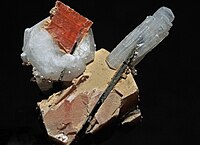
Photo from wikipedia
The accurate estimation of temperature distribution in the earth's crust and modeling of heat-related processes in geodynamics requires knowledge of the thermal conductivity of plutonic rocks. This study compiled an… Click to show full abstract
The accurate estimation of temperature distribution in the earth's crust and modeling of heat-related processes in geodynamics requires knowledge of the thermal conductivity of plutonic rocks. This study compiled an extensive dataset of 530 representative plutonic rock samples, including thermal conductivity, major oxide composition and (for two subsets of data) modal mineralogy. For the first time, three machine learning algorithms (ML; i.e. support vector regression, random forest and extreme gradient boosting) were employed to estimate the thermal conductivity of plutonic rocks using the major oxide composition feature as input variables. The performance of these ML-based models was evaluated against a geochemically-compositional model and eight mineral-driven physically-based empirical mixing models. Results show that the means of predicted thermal conductivity by the ML-based models and the geochemically-compositional model are not significantly different from the measured thermal conductivity at a significance level of 5 per cent. However, the ML-based models outperformed the best-performing non-ML model, the geochemically-compositional model. The highest prediction accuracy was achieved by extreme gradient boosting, which reduced the mean absolute percentage error and root mean square error by more than 50 per cent. Furthermore, SiO2 is confirmed as the most important independent variable, followed by Al2O3, TiO2, CaO, and K2O. The turning point observed in the thermal conductivity trend with SiO2 wt- per cent may be primarily attributed to variations in mineral composition within the subgroup of igneous rock types classified based on SiO2 wt- per cent. The present study explores, for the first time, the use of ML algorithms to estimate the thermal conductivity of plutonic rocks from their major oxide composition.
Journal Title: Geophysical Journal International
Year Published: 2023
Link to full text (if available)
Share on Social Media: Sign Up to like & get
recommendations!